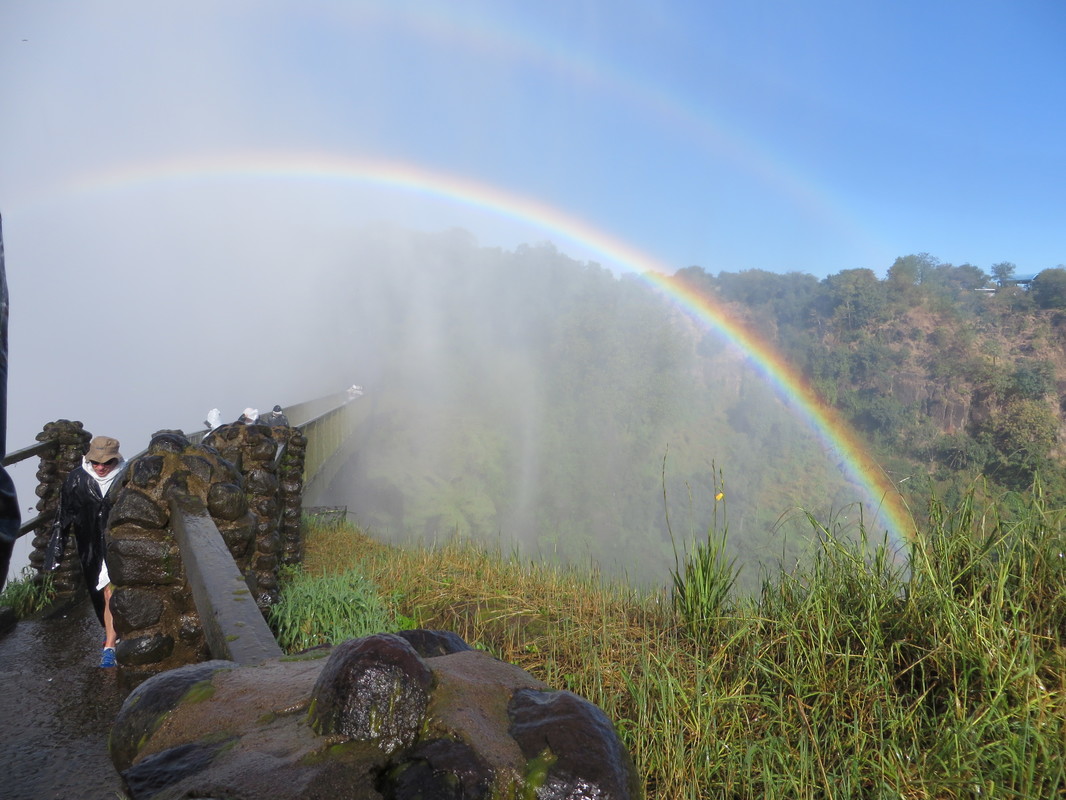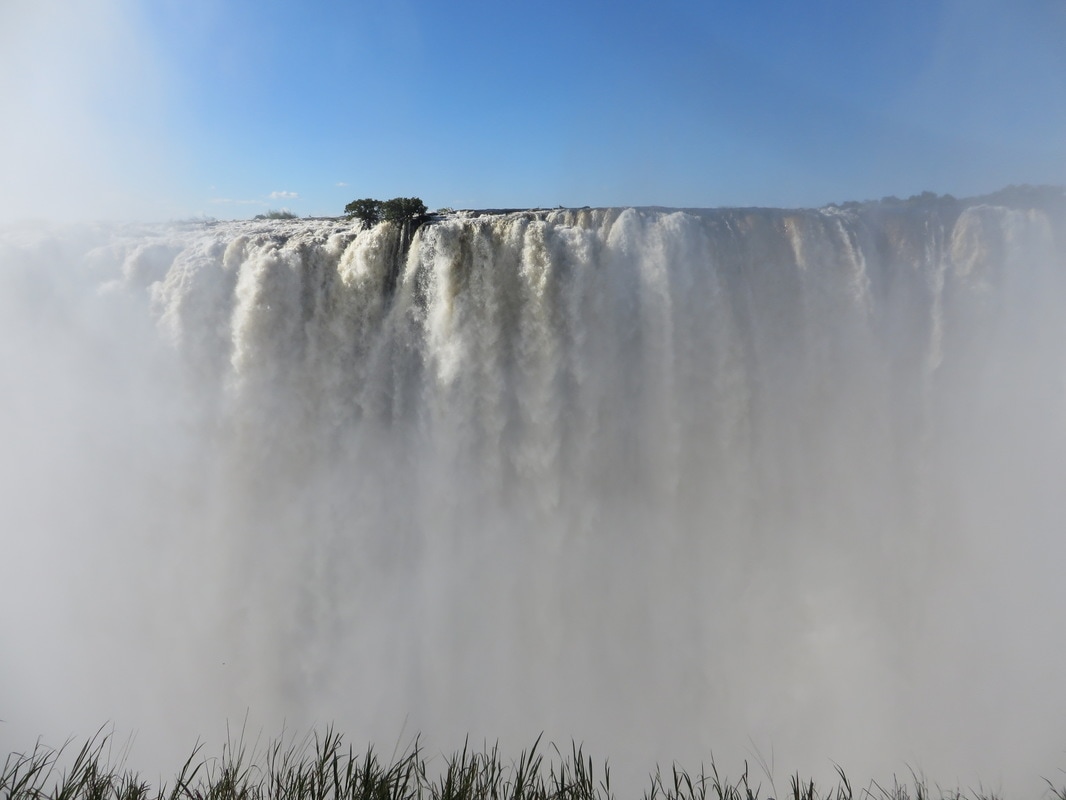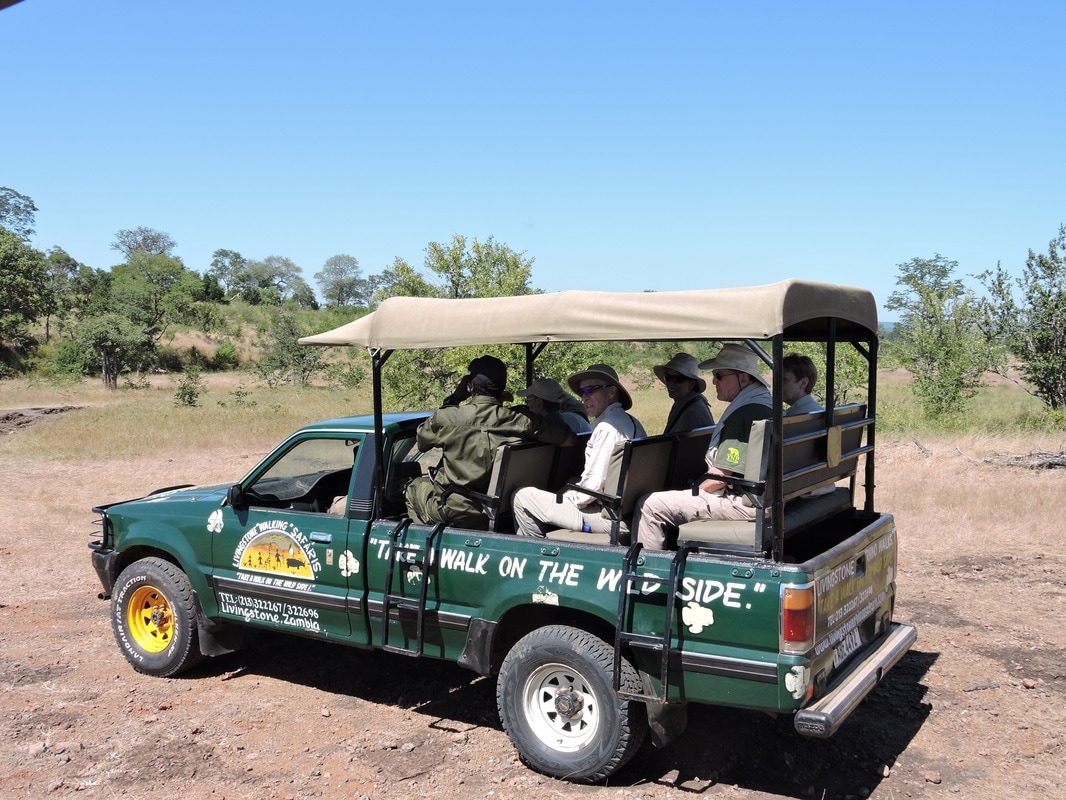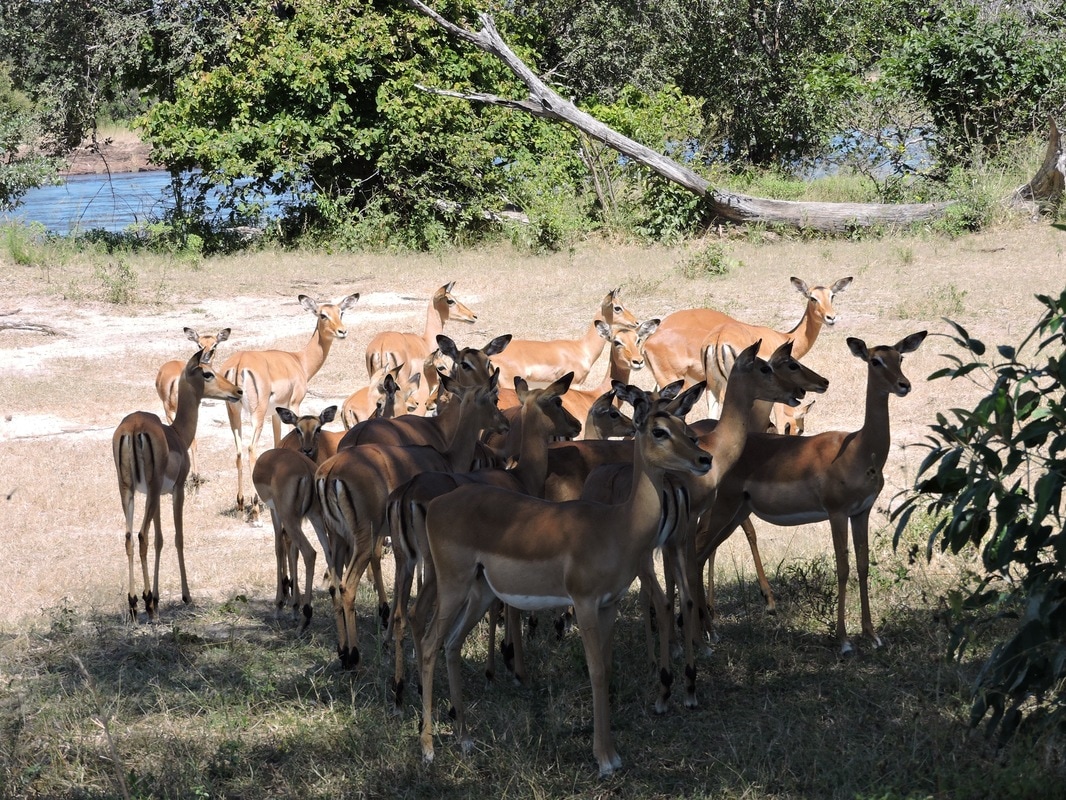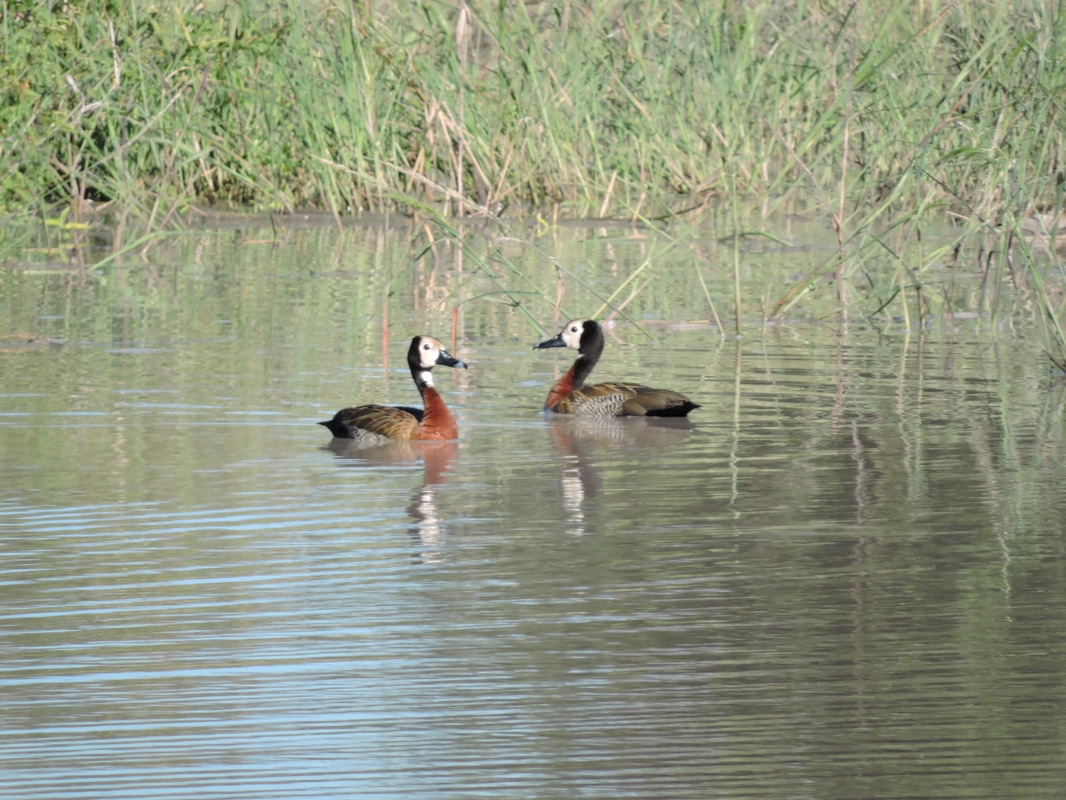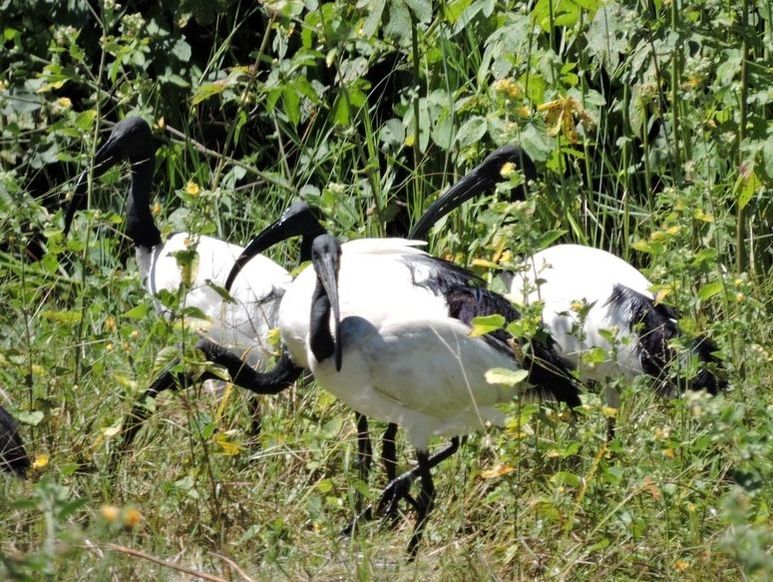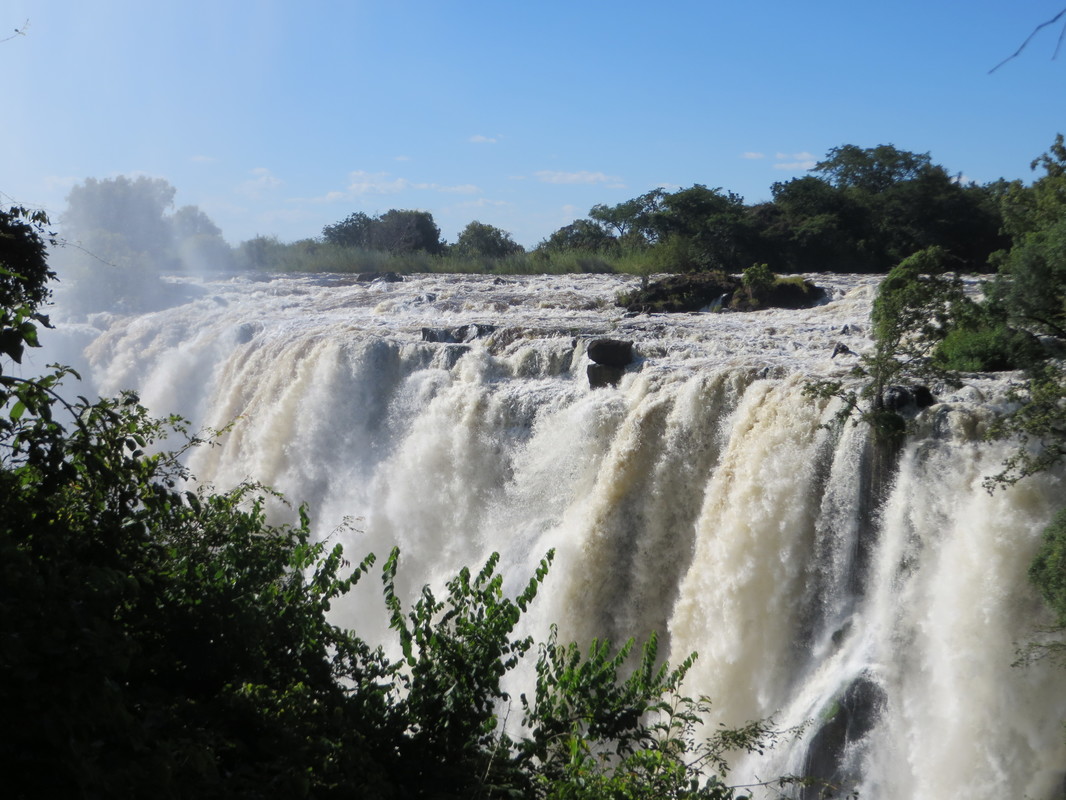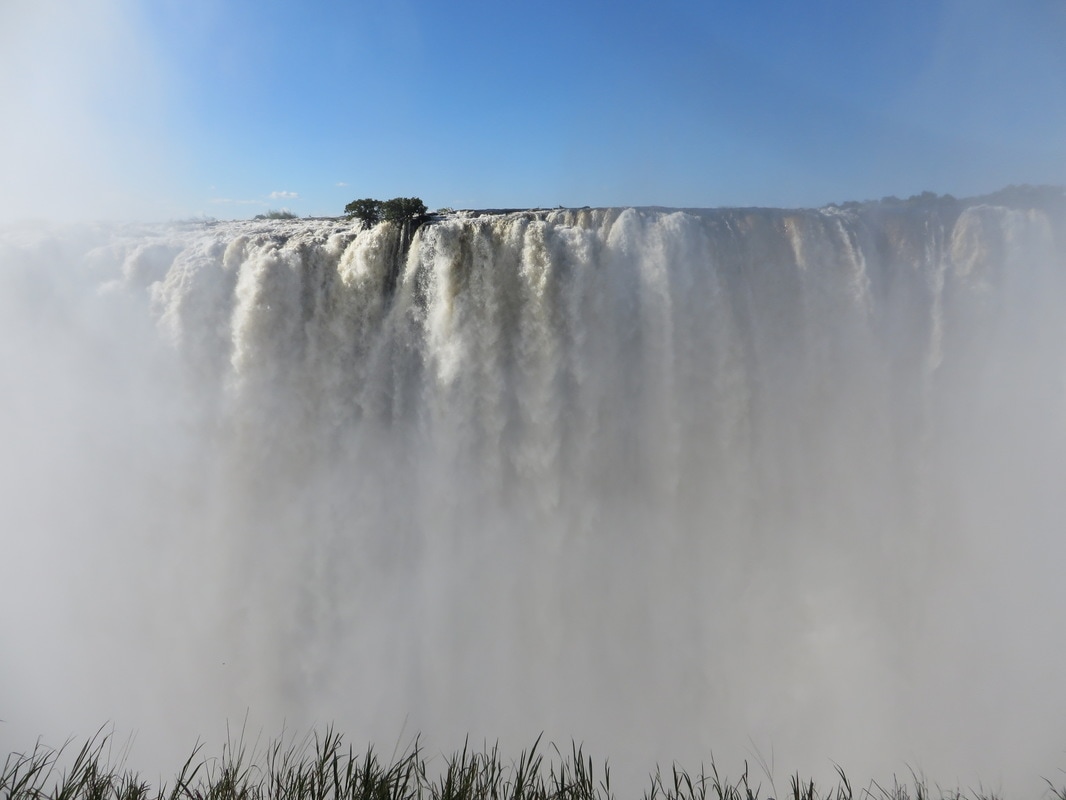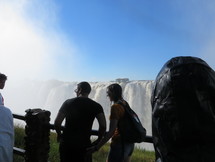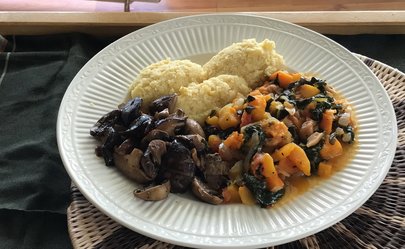|
|
On the Zambezi
An elephant arrives for
A drink of water.
|
This spring, Wayne and I embarked on an autumn encounter with three countries located in the southern hemisphere: Zambia, Botswana and South Africa. Our intention was three-fold, to interact with the people and learn something of their culture and values, to enjoy the animals in their natural habitats and to sample the local food. In all three countries, we ate well, saw hundreds of healthy animals living free and had the pleasure of meeting some of the most courteous and dignified human beings on earth. And we missed no opportunity to enjoy Afternoon Tea.
Our journey began in Zambia in the town of Livingstone, a colonial looking place with lots of 1920-1930s buildings and women in traditional clothing carrying their parcels on their heads. We boarded a water taxi on the Zambezi River to take us to our lodging, The Royal Livingstone Hotel. On the way, a large male elephant with impressive tusks stepped out of the dense foliage along the river bank to get a drink of water. Our little boat almost ran into him, affording us a very close look at this handsome creature, the first of many elephants we were privileged to encounter in our three-country travels.

The Royal Livingstone Hotel has an elegant ambience with colonial style architecture and wide, beautifully maintained lawns sloping down to the Zambezi River. Zebras and even giraffes quietly graze on the grassy grounds and among the shady trees that grace the setting. The hotel is located in the Mosi-oa-Tunya National Park and provides not only views of the resident animals and the mighty Zambezi, but also of Victoria Falls, a short distance away. Our first view of the falls was truly breathtaking, as we witnessed huge plumes of water spewing into the sky above the falls just at twilight. The Zambian name for the falls, Mosi-oa-Tunya, translates as “The Smoke that Thunders,” and indeed the copious amounts of skyward-moving water above the falls did resemble smoke.

That evening, we had the old-fashioned fun of riding the Royal Livingstone Express, a restored 1920s steam train with a charming retro dining car. We chugged along on our sixteen-mile scenic journey to the Victoria Falls Bridge on the Zimbabwe border. Here we disembarked from the train and wandered along the railway bridge, viewing the truly thunderous falls below from a viscerally close angle. The spray was so massive that the rainbows it generated arched downward into the gorge below as well as up into the sky. On the trip back, we enjoyed a five-course dinner in the romantic dining car featuring some local fare. Wayne was served kudu, an African game meat, in two forms, a carpaccio with goat cheese and in a Zambian style pot pie. Wayne said the kudu, an antelope-like animal, tasted like very lean venison. I enjoyed barramundi, a river fish, and I was also served a vegetable curry with rice, an example of the wide spread Indian influence in the cuisines of southern Africa. Our dessert was coconut cake served with custard sauce in the British style along with minced fresh pineapple. Very good chocolate truffles and coffee concluded our meal.
There are two compelling reasons to visit Zambia. We had our first glimpse of the UNESCO World Heritage Site, Victoria Falls, Zambia’s primary claim to fame, and would have another opportunity to view the falls at even closer proximity. Zambia’s second great treasure is its southern white rhinoceros population, protected in the Mosi-oa-Tunya National Park. “White” and “Black” are misnomers for rhinos, as both species are gray in color. The word “white” is a confusion of the Afrikaans word “weid” meaning “wide,” referring to the wide shape of a white rhino’s mouth in contrast to the somewhat pointed shape of a black rhino’s mouth. The wide mouths of the white rhinos allow them to graze easily on grass. We took a walking tour in the park with Newton, our young and well-informed local guide, and a ranger with a rifle who assured us that he would only shoot into the sky if a rhino decided to charge. Fortunately, this did not happen, but the protection of rhinos from the nefarious practice of poaching is serious business in Zambia, and rangers were present throughout the park to assure the safety of the precious and drastically endangered rhinos.
The park is a large, grassy and slightly hilly area along the Zambezi River, which is full of crocodiles. There are lots of rocks, large and small, all over the area, caused by volcanic activity eons ago, so we had to be careful as we walked. In addition to the grasses, there were mopane trees of various sizes everywhere. Newton informed us that the mopane is the elephant’s favorite food, and a mother elephant will even unearth a mopane tree so that it falls over, allowing her baby to eat the leaves.
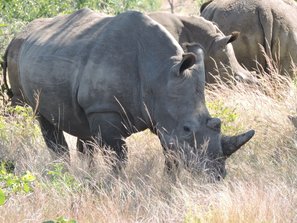
We saw no elephants in the park today, but as we walked up a small rocky rise, we came upon a group of five rhinos, very close, including a huge male and a baby. The mother was keeping close watch over the baby. The grazing group moved several times while we were watching them. We moved with them at a respectful distance. It was an honor to witness this ancient species, feeding together quietly as a family, free from the horrors that have befallen so many of their fellows.
After our walk with the rhinos, we boarded an open sided safari vehicle which took us to another area of the park for animal viewing. But first we stopped by the Zambezi River for our morning snacks—fresh lemonade, very good homemade ginger cookies and pound cake served from the hood of the vehicle. As we enjoyed our refreshments, we spotted a monitor lizard and a crocodile near the riverbank. Other animals we were fortunate to see on our afternoon game drive included a group of giraffes including a mature female and three juveniles, a golden, fluffy vervet monkey, several herds of beautiful and graceful impalas, and a male puku, an impressive antelope-like animal with large curving horns graced with horizontal stripes.
Bird watching was also exciting in the park. We saw majestic African fish eagles, Egyptian geese, hornbills, kingfishers and the ever-present melodious doves. Newton used an amusing phrase to describe the dove’s call, and I turned it into this haiku:
|
The African Dove
Calls, “Drink lager, save water,”
In the dry season.
|
|
At lunch time, we visited another hotel on the Zambezi River named after the famous Scottish explorer—The David Livingstone Hotel. We boarded a boat at the hotel’s dock and cruised along the river, eating fresh tilapia with nicely cooked vegetables and a very fresh Greek salad. I was not surprised by the prevalence of Afternoon Tea and custard laden desserts considering Britain’s influence throughout Africa from the Victorian era to the Twentieth Century. But I was startled to be served so much Greek, Italian and Indian food in all three of the countries we visited. Perhaps the African tourism industry is convinced that American tourists prefer European food, and Indian immigrants have added to the diversity of Zambian cuisine.
During our luncheon cruise, we saw hippos, some making very loud noises, as we floated along. We saw more Egyptian geese and beautiful sacred Ibis with their curving beaks, feeding in the shallows of the river bank. While we were on the boat, one of our local guides, whose name happened to be David, enlightened us with the Zambian version of the life and achievements of David Livingstone, for whom almost everything in this part of the country is named. I remember learning about this famous Victorian explorer and medical missionary when I was in the fourth grade, a very long time ago. My take away from this elementary school history lesson was that David Livingstone “discovered” Victoria Falls and was later “discovered” himself, (after disappearing for several years in the heart of Africa) by the Welsh-American journalist, Henry Morton Stanley, who upon finding Livingstone, uttered the famous words, “Dr. Livingstone, I presume.”
Clearly Livingstone did not discover the Mosi-oa-Tunya. He was simply the first European to see it and took it upon himself to re-name the falls after Queen Victoria. Everyone living in Zambia at the time of Livingstone’s arrival was obviously aware of the falls’ existence, as the sprays of water shooting into the sky are impossible to miss. But David, our local storyteller, was very kind to Dr. Livingstone, who is a hero in Africa, not because of the falls, but because he learned about the Arab slave trade, and carefully documented this odious activity in his journals. Though Livingstone died in Africa in 1873, Stanley protected his journals, and published an expose on the southern African slave trade, leading to its abolition. Livingstone was also apparently far kinder and more considerate in his treatment of Africans than can be said of most other Europeans of that era, including Henry Morton Stanley.
Our final adventure in Zambia was a walking tour of Victoria Falls which took us directly into the torrent, soaking us to the very bone, and leaving a lasting impression of the falls’ power and grandeur. Our trek into the falls took place on a Sunday afternoon, and I was pleased to see many Zambian families enjoying an outing to their own world famous natural wonder. As we approached the falls on foot, we came to a stopping point where we donned waterproof shoes and two layers of plastic ponchos. Even with this protection, the rest of the journey resembled a walk through a cyclone. We were inundated, surrounded by rainbows and rocked by the relentless and reverberating sound of endless amounts of falling water. The volume of the downpour was so intense that we were walking, not just through puddles, but through rivers of moving water, over our feet and up our legs. Our trek took us over a bridge across the gorge where we witnessed more rainbows and glimpsed the enormity of the waterfall, twice the height of Niagara Falls, and gazed in awe down at the swirling gorges below.
|
|
Zambian children
At the falls sparkle, their hair
Filled with water drops.
|
Our last Zambian dinner was at the restaurant of the Royal Livingston Hotel, where the menu featured a Eurocentric selection that included roast duck, roast lamb, and a rather nice pureed vegetable soup. I was embarrassed to order penne arrabiata in Africa but could find no other vegetarian entrée options. My dessert of chocolate lava cake with ice cream could have been on any American restaurant menu, but it was delicious.
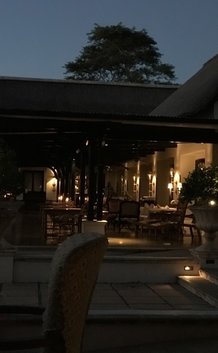
Zambians who prepare their own food, particularly those living in traditional villages, rely on river fish, chicken, beef and staples that they can grow in their own kitchen gardens. Corn, called “maize” in Zambia, (from “maiz,” the Spanish word for corn,) is the starch of choice, especially in the form of cornmeal mush (called nshima,) which can be served at any meal of the day. Popular garden vegetables include pumpkins, squash, spinach, onions, tomatoes, beans, cabbage, okra and sweet potatoes. Peanuts also grow in Zambia. Does this sound familiar? Those of you who live in the American South or have a southern heritage might recognize these foods as the ingredients in your grandmother’s everyday cooking. The African and Southern American culinary connection is a strong one, not surprising when one considers the powerful historic confluence between the two continents and the continuing creativity and vitality of African American culture. Contemporary African culture is also diverse and ever changing. And as I have already pointed out, Zambians are open to culinary influences from all over the world.
As we prepare to ferry across the Zambezi river from Zambia to Botswana, I will leave you with the recipe for a very traditional Zambian meal which you can easily cook in your own kitchen—good old vegetable stew with corn meal mush. I made this delicious meal in my own kitchen shortly after returning home from Africa. Wayne and I both loved it, and I had no difficulty finding all of the ingredients in our local grocery store and farmers’ market.
Ifisashi with Nshima
(Zambian Peanut and Vegetable Stew with Corn Meal Mush)
Ifisashi, or peanut and vegetable stew, is the go-to Zambian family meal. It is perfect for home gardeners, which many Zambians are, as the cook can simply go out in the back yard and harvest any of the vegetables that are ready to be picked. The inclusion of roasted peanuts makes this dish a nutritional powerhouse, and it is loaded with the green and yellow vegetables that we have all been taught to include in our daily diet. Ifisashi is traditionally served with nshima, the ubiquitous Zambian corn meal mush (or polenta, if you prefer.) Keep in mind that Zambia’s national dish is not fast food. It will take you some time to wash and cut up the vegetables. I expedited the process by oven roasting the squash and sweet potato the night before so they could be ready to be peeled, chopped and added to the stew the next day.
Ifisashi is a vegetarian dish, which is my preference, but I served Wayne’s ifisashi with sausages. You could turn your ifisashi into a family dinner, or even a special meal with friends, by adding another protein to the menu. Pan fried river fish, such as catfish or trout would be good with corn meal and vegetable stew, as would grilled chicken, pork chops or even broiled hamburger patties. These recipes will produce about eight servings, and we discovered that ifisashi is just as good, if not even better the next day. For a large group, both recipes can be doubled.
For the Nshima:
- 2 cups corn meal (fine grind)
- 4 cups water
- ½ teaspoon salt
Special equipment: measuring cups and spoon, large cooking pot with lid, whisk or immersion blender
Makes: approximately 8 servings
- Bring 4 cups of water and ½ teaspoon of salt to a boil over high heat in a large cooking pot. Make sure the pot is large, not medium sized, as the cornmeal can boil over and splatter on your stove and your hands.
- Reduce the heat to medium and gradually add the cornmeal, whisking to avoid lumps. I use an immersion blender. The mixture will thicken.
- Turn the heat down to low and continue to cook and whisk for an additional 3-4 minutes until the mixture is thick and smooth. Cover the pot with the lid and place it on the back burner of the stove without heat until the ifisashi is cooked and ready to serve.
- Nshima is traditionally served in two or three torpedo shaped portions per person, not cut into squares. To create nshima “croquettes,” use a large serving spoon and twist it in a circular fashion through the cooked corn meal, releasing each nshima portion onto an individual plate.
For the Ifisashi:
- 3-4 tablespoons peanut oil, divided
- 1 cup lightly salted roasted peanuts
- 1 large sweet onion, chopped
- 2 medium or 3 small tomatoes, chopped
- 1 small butternut squash
- 1 sweet potato
- 1 large bunch of spinach, carefully washed, stemmed and chopped
- 1 small head of cabbage, finely shredded
- 1 cup water or chicken broth
- salt and pepper to taste
Special equipment: large roasting pan, large skillet, wooden spoon, large cooking pot with lid, sharp knife
Makes: approximately 8 servings
Preheat oven to 350°F
- Early in the day or the night before, cut the squash into 4 pieces with a sharp knife, cut the sweet potato in half and place the pieces, skin sides down, into a large roasting pan. Drizzle lightly with peanut oil, sprinkle with salt, and turn the pieces over, skin side up. Roast for approximately 1 hour, until the chunks have softened. Cool for about 1 hour, peel, seed the squash and cut all of the chunks into small pieces. Cover and refrigerate overnight, or reserve to add to the ifisashi in step #4 if making it immediately.
- Place 2 tablespoons of peanut oil in a large skillet, add the chopped onion and cook on medium heat until the onion softens and turns a light golden color. Add the chopped tomatoes and peanuts and continue to cook, stirring with a wooden spoon until the tomatoes have softened. Transfer the vegetable mixture to a large cooking pot and continue to cook, stirring, on low heat.
- As the onion mixture continues to cook, add 2 more tablespoons of peanut oil to the skillet and add the shredded cabbage. Stir fry over medium high heat until the cabbage turns a light golden, and transfer it to the large cooking pot. Add 1 cup of water or chicken broth to the large pot and stir the vegetables.
- Add the cubed squash and sweet potato pieces and stir carefully. Cover and simmer for about 30 minutes, stirring occasionally. Add the chopped spinach, stir and cook for another 10 minutes or more until all the vegetables are cooked and the stew is well blended. Sprinkle with salt and freshly ground pepper to taste.
- To serve, place 3 rounded portions of nshima on each plate and place a generous serving of ifisashi next to the nshima. Add a small serving of cooked meat or fish to the plate, or eat as a vegetarian meal. I served my nshima and ifisashi with stir-fried fresh mushrooms.




